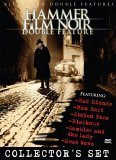| Reviews & Columns |
|
Reviews DVD TV on DVD Blu-ray 4K UHD International DVDs In Theaters Reviews by Studio Video Games Features Collector Series DVDs Easter Egg Database Interviews DVD Talk Radio Feature Articles Columns Anime Talk DVD Savant Horror DVDs The M.O.D. Squad Art House HD Talk Silent DVD
|
DVD Talk Forum |
|
|
| Resources |
|
DVD Price Search Customer Service #'s RCE Info Links |
|
Columns
|
|
|
Hammer Film Noir Collector's Set, Vol. 1-3
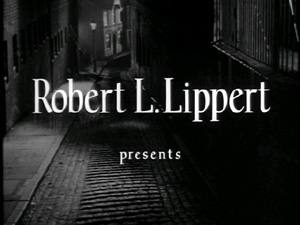
The British production studio Hammer Films is best known for its long back catalogue of stylish horror films, but VCI Entertainment has unearthed a much less-heralded excursion into a genre more common to the American studios: film noir. Born out of a deal with U.S.-based producer Robert L. Lippert, an experienced maker of B-movies (including several by Sam Fuller), these productions were a joint venture where British and American talent was coupled to create a string of crime movies. All the films were made in the early 1950s, and this new collection, the Hammer Film Noir Double Feature Collector's Set, puts six of them onto 3 DVDs (also available separately).
The historical interest of this sextet is undeniable. That means the question, of course, is whether or not these films were any good, or if they were buried for a reason. And then, where do they fit in the larger film noir canon.
Disc 1
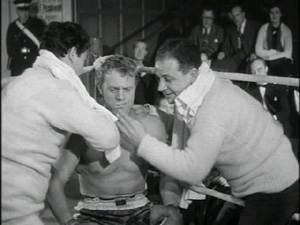
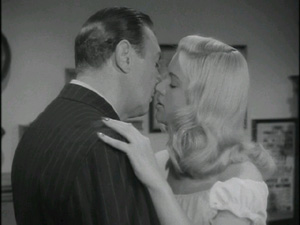
* Bad Blonde (UK title: The Flanagan Boy - 1953): A pretty standard story. Johnny Flanagan (Tony Wright) is an up-and-coming boxer who gets involved with the wife of his promoter. The bad blonde in question, Lorna (Barbara Payton, Kiss Tomorrow Goodbye), is an American girl who married the much older Giuseppe (Frederick Valk, The Colditz Story) for his money. Once she has her clutches on Johnny, Lorna does what any good femme fatale would and gets him to kill her husband. What she doesn't count on is Giuseppe's old world Italian family, who see through her ruse and complete the jellification of Johnny's spine by giving him the evil eye and making menacing pronouncements of guilt. As Johnny crumbles, so does her story.
Veteran director Reginald Le Borg (the Joe Palooka series) brings a conservative hand to what should have been a steamier potboiler, and the final product comes out a little tepid. Wright stumbles through the movie like a punch-drunk composite of Joseph Cotton and "Route 66" start Martin Milner, and his empty gaze needs a flashy counterbalance. Payton, sadly, is not it. She is the least vamping vamp I've seen in a while, and her downfall is nowhere near as salacious as one expects from classic noir. Valk is great as the larger-than-life Giuseppe and the boxing matches have a raw documentary feel, but it's not enough to raise Bad Blonde above a C-grade B-picture.
* Man Bait (UK title: The Last Page - 1952): A much more luscious and by all accounts more dangerous blonde is Diana Dors, who plays Ruby, the pouty lipped invoice clerk at an upper-end bookstore. Ruby and her curves are the source of a wrong-man-accused scenario. She gets involved with petty criminal Jeffrey Hart (Peter Reynolds), and he pushes her to exploit a moment (and I mean, a moment) of indiscretion with her boss, John Harman (George Brent). It soon gets more tangled than anyone expected, and Harman ends up with Ruby's troubles stacked on his stalwart shoulders.
Terence Fisher would go on to direct a lot of the Hammer horror films, but in Man Bait he seems to get hung up on the quiet respect of the bookstore setting. Though the film is filled with twists and turns, and the blackmail plot has its share of salacious elements, the players keep their distance most of the time. Dors generates a sexy heat, Reynolds oozes slime and smarm, and Brent does his best to bring respectability to it all, but in the end, Man Bait comes off as stiff. Raymond Huntley as the petty bookstore manager is actually the more sinister villain just because he's such an uptight jerk, and when a side character gets the most hisses just for scolding the pretty girl for being late, you know something is off-kilter. The script for Man Bait might have been better played as overwrought melodrama than a pulp magazine double-cross.
The first disc isn't so much bad as it is underwhelming.
Disc 2
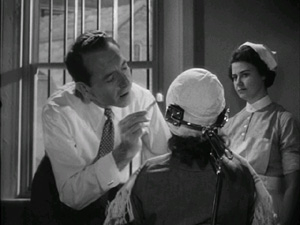
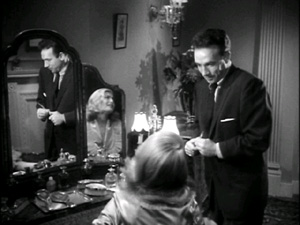
* Stolen Face (1952): Terence Fisher also directed Stolen Face, and the results are markedly better. This could be down to the elements of mad scientist horror that creep into the script, but the bulk of it is thanks to the commanding presence of Paul Henreid (most famous as Victor Laszlo in Casablanca). He plays the well-meaning but arrogant Dr. Philip Ritter, who is pioneering the fusion of plastic surgery and psychology by fixing the physical deformities of habitual criminals. His theory is that if they can pass as a "normal" member of society and feel more confident about their appearance, they won't be driven to crime.
On a weekend getaway, Philip meets and falls in love with Alice Brent (Lizbeth Scott, Dead Reckoning), a concert pianist who it turns out is already engaged. Distraught that he can't be with her, Philip decides he is going to make over his next patient in her image. Scott doubles as the post-surgery Lily Conover, a career criminal who isn't at all interested in changing her stripes. When Alice returns to the scene, Dr. Ritter has more on his hands than he can cope with.
A pulp fiction Eyes Without A Face, Fisher's Stolen Face does stray into noirish territory with its themes of trying to escape a haunted past by recasting it in a different identity, a la Bogart's Dark Passage or another Paul Henreid vehicle, The Scar. (Interestingly, the second flick is almost the flipside to Stolen Face. In The Scar, Henreid plays a criminal who steals a doctor's identity by disfiguring his own face.) The duo (trio?) of Henreid and Scott work exceptionally well together. Scott in particular does great in her double duty, not just putting on a heavier Cockney accent for Lily, but changing her physical gait, as well. Fisher builds to some real tension in the climax, though the humor and twists are more Hitchcockian than noir. Even so, a nicely done thriller.
* Blackout (UK title: Murder by Proxy - 1954): Third time continues to be a charm for Terence Fisher. An American ex-patriot with a drinking problem gets propositioned in a high-falutin' jazz bar by a gorgeous blonde. She'll pay him a healthy sum of money if he marries her. Doesn't sound too bad, does it? Next thing Casey (Dane Clark, Gunman in the Streets) knows, he's waking up in a strange bed, unsure of whether or not he's a newlywed. The girl that could be his wife, Phyllis (Belinda Lee, Man of the Moment), just so happens to be in the morning paper. Turns out she's a rich heiress whose father was killed the night before, and no one knows where she is. So, not only could he be married to this girl, but the money in his pocket might be the money she paid him to rub her old man out.
Blackout is a taut thriller. It doesn't necessarily move at D.O.A. speeds, but it barely pauses as Casey goes on the hunt to find out who really killed his maybe father-in-law and clear his name. Along the way, he runs afoul of Phyllis' real fiancé (Andrew Osborn), his goons, and a pair of mothers, Phyllis' mom and his own. He also happens to fall for the girl who is either his wife, the one who has framed him, or both. Fisher changes locations often, including some excellent on-location photography, and carries his audience through several twists as Casey unravels the plot that lead to the killing. Most charming amongst the excellent character actors that help and hinder the desperate man along the way is Eleanor Summerfield (The Millionairess). She plays Maggie, the painter whose bed Casey passed out in. She has a calming aura around her, serving the same role as Virginia Huston in Out of the Past, but without the romantic interest. Maggie provides the peaceful lulls where Casey, who is played with a wild-eyed vigor by Clark, can gather his head. Belinda Lee is also excellent, flipping the switch from seductress to scared little girl to tender romantic without missing a beat.
On the whole, disc 2 of the Hammer Film Noir Double Feature Collector's Set is miles ahead of disc 1 in terms of viewer enjoyment. The stories are still a little toothless, lacking the hair-trigger tension of quintessential noir, but they are still nail-biters that kept me guessing right up until the end.
Disc 3
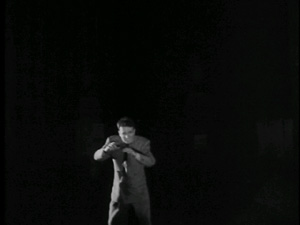
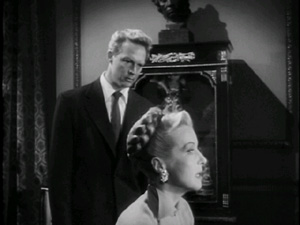
* The Gambler and the Lady (1952): Dane Clark returns as Jim, an American with a haunted past who runs illegal card games in England by night while learning to be a proper British gentleman during the day. Things go wrong when a pair of gangster brothers from the States move in on his territory right at the same time he starts a relationship with a society lady (Naomi Chance, The Saint's Return). A jilted girlfriend and a disgruntled ex-employee both resent Jim's attempt to outrun his history and raise his station, and his trusted assistant (Thomas Gallagher) tries to warn him that the upper crust are just as nasty underneath as the criminals they look down their noses at. Jim won't be dissuaded by anyone, so naturally it's all going to blow up in his face.
This feature had up to three directors. Patrick Jenkins was the British director brought in so the production unions would allow Sam Newfield to stay on the project. Newfield was an American, and since he had just finished another Hammer feature, it would have been a violation of the rules for him to helm another one solo when native directors were just standing around. It's also alleged that Terence Fisher may have had a hand in it, but he receives no official credit. Whatever the combination, The Gambler and the Lady is the most action-packed movie in VCI's DVD set. It has the most immediate and striking opening sequence, and fans looking for a shootout finally get their wish. Clark is excellent once again, this time showing a little more comedy thanks to the scenes where Jim takes etiquette lessons.
* Heat Wave (UK title: The House Across the Lake - 1954): Written and directed by Ken Hughes (the 1967 Casino Royale), Heat Wave employs the regular film noir convention of a man who has run out of rope confessing his story to an unseen presence (the audience). Novelist Mark Kendrick (the film's requisite American, Alex Nicol, also known for Jacques Tourneur's Great Day in the Morning) is found by a mysterious figure at the bar where he is drowning his sorrows, and Mark's ready to spill them out. Cut to Mark wrestling with his typewriter at his lakeside home, looking across the water at an opulent house and the fancy lights on its dock (how Great Gatsby!). Carol Forrest (Hillary Brooke, Abbott and Costello Meet Captain Kidd), a rich and glamorous blonde, phones him and asks him to ferry her friends across the lake, and of course, he ends up ferrying himself to his own doom.
Sid James, who is also in Bad Blonde, plays Beverly Forrest, the man who has acquired Carol as his trophy wife. He befriends Mark and is actually the one to suck the writer into the messy world of his family. Carol cheats on him regularly, and his daughter (Susan Stephen, who had a small role in Stolen Face) sees everything and isn't willing to keep her mouth shut about it. Mark, of course, is going to fall for the curvy temptress and murder is inevitable. The machinations of the plot are involving, but the switch-ups that lead to Mark's seat of confession are once again notably lacking in violence. Mark more gives up than fights for his survival, and it ends up being a letdown after a sultry build-up.
Disc 3 is another pleaser, its two films thematically linked by wandering Americans who get into trouble by trying to run in well-to-do British circles. What Heat Wave lacks in its climactic temperature is more than made up for in The Gambler and the Lady's bullet-riddled finale.
***
The Hammer Film Noir Double Feature Collector's Set scores a pretty good hit-to-miss ratio. I unequivocally enjoyed more than half of the sextet, and the others were at least mild distractions.
As far as film noir goes, DVD fans have seen a lot of collections lately that push the definitions of the genre a bit far. While the six movies here aren't necessarily that far off from what one should expect in a film noir box, there is a notable difference between them and the classics of the form. The most obvious is their lack of the dark visual style and the verbal patter of traditional American noir (or even their French counterparts). It feels a tad cliché to say, but it seems to me that it has something to do with the British mentality. A case can definitely be made out of the fact that the more diabolical of the characters in these selections end up being Americans, and the British players all stand around amused by the bizarre behavior of these wild yanks (think in particular the scenes of Dane Clark amongst the aristocrats of The Gambler and the Lady). The Hammer Films represented here are much more polite than hardboiled stories are supposed to be. At times, they are positively demure. Perhaps that is why this Hammer sidebar has not been as celebrated as the studio's later horror efforts. These movies could have definitely benefited from a glimpse at Hammer's future, as had the directors embraced the lurid fun that was to come, this Hammer Film Noir Double Feature Collector's Set would be a lot more stimulating. The guys just don't seem that tough, and the women aren't the conniving sex bombs film noir is usually populated with. Add to that a distinct lack of noir's trademark impressionistic visual style. There are no odd, paranoid camera angles or rainy streets and more often than not, the sets are brightly lit and absent of dark corners. Hell, only one movie, Heat Wave, even has a voice-over. Film noir practically invented voice-over!
The end effect is worth watching, but more for their own merits than as part of the larger movement. In that sense, Hammer noir comes off as a lower-tier copy. This fictionally seedy underbelly of England lacks the shadows, both physical and psychological, that are the defining factors of more conventional film noir. Since some of the better films were made later in Lippert's run, it's possible that Hammer was only just getting warmed up when the relationship reached its finish, and given a few more tries the studio might have found a more distinct voice. However it might have turned out, what we're left with is an odd footnote to a popular genre, and one fans might enjoy as a mild diversion.
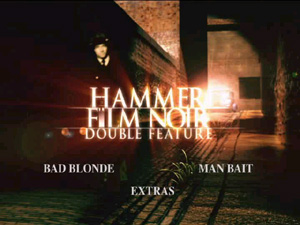
THE DVD
Video:
All six movies are in 1.33:1 full screen aspect ratio. VCI has found surprisingly pristine prints of most of the films, so the black-and-white photography looks excellent. The one main exception is Man Bait. It has occasional flickers and a line down the screen in a couple of scenes. The Gambler and the Lady also has some lines, and Stolen Face has a few scenes that get a little soft. Everything else is solid, though, with a healthy contrast of dark blacks and strong whites.
Sound:
The movies have a no-frills digital mix that is all right. Most of the time, it's just fine, but if the on-screen action gets loud, or if you turn up your sound system past a certain level, you will experience some distortion (this is mainly on disc 1). In addition to a movie that has an image of lesser quality, Man Bait also has sub-par sound that is marred by background static through the entire film. I could still hear everything, and eventually my ears adjusted and I no longer noticed, but it's worth noting. Stolen Face has a little hiss as well, but only intermittently.
Extras:
The discs all include three trailers. Only on the first disc, however, are they for the films on the DVD, the rest are for other VCI crime titles. The individual movies also have text bios for members of the creative team. They run like actual filmed features, and the page changes on its own, or you can skip ahead with the "chapter next" button.
Author Richard M. Roberts provides a sort of commentary for the movies. Rather than talking over the features themselves, he recorded short monologues with background information that plays over stills and promo items from the movie being discussed (all are under ten minutes, most even under five). He has also recorded a short history of the Hammer Studios foray into the film noir genre (this is on all three DVDs). While his text is informative, his delivery leaves a little something to be desired. He has a jokey nature that doesn't always work (such as when he sings a tune for us, or gets more sarcastic and overacts), and the way he over-pronounces "noir" makes him sound like Adam Sandler's Cajun character from Saturday Night Live. Someone in the editing booth wasn't paying attention when everything was put together, either. During Bad Blonde, Roberts instructs the production team to cut and back up, and then he repeats himself, doing a different take of a story. Apparently no one noticed the cue.
FINAL THOUGHTS:
Recommended. Even if I might grumble a little about the particularities of noir, the Hammer Film Noir Double Feature Collector's Set is a mostly enjoyable look at a British excursion into hardboiled B-movies. The results are varied, but particularly the second and third discs have well-matched double features that get close to the dark heart of crime films.
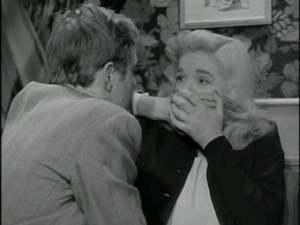
Jamie S. Rich is a novelist and comic book writer. He is best known for his collaborations with Joelle Jones, including the hardboiled crime comic book You Have Killed Me, the challenging romance 12 Reasons Why I Love Her, and the 2007 prose novel Have You Seen the Horizon Lately?, for which Jones did the cover. All three were published by Oni Press. His most recent projects include the futuristic romance A Boy and a Girl with Natalie Nourigat; Archer Coe and the Thousand Natural Shocks, a loopy crime tale drawn by Dan Christensen; and the horror miniseries Madame Frankenstein, a collaboration with Megan Levens. Follow Rich's blog at Confessions123.com.
|
| Popular Reviews |
| Sponsored Links |
|
|
| Sponsored Links |
|
|
| Release List | Reviews | Shop | Newsletter | Forum | DVD Giveaways | Blu-Ray | Advertise |
|
Copyright 2024 DVDTalk.com All Rights Reserved. Legal Info, Privacy Policy, Terms of Use,
Manage Preferences,
Your Privacy Choices | |||||||









